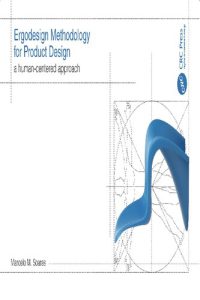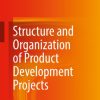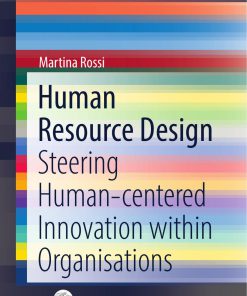Ergodesign Methodology for Product Design: A Human-Centered Approach 1st Edition by Marcelo 9781000454086 1000454088
$50.00 Original price was: $50.00.$25.00Current price is: $25.00.
Ergodesign Methodology for Product Design: A Human-Centered Approach 1st Edition Marcelo M. Soares – Ebook Instant Download/Delivery ISBN(s): 9781000454086, 1000454088

Product details:
- ISBN 10:1000454088
- ISBN 13:9781000454086
- Author: Marcelo
Ergodesign Methodology for Product Design
A Human-Centered Approach
Table contents:
Chapter 1 Introduction
Questions This Book Aims to Answer
Chapter 2 The Design of Ergonomic Products: Ergodesign
2.1 Ergonomically Well-designed Products
2.2 Ergonomics and Product Design: Bridging the Gap
2.3 Summary of the Chapter
Chapter 3 The Product Design Process
3.1 Product Development and the Product Design Process
3.2 Design Specification
3.3 Generation of Design Concepts
3.4 Modeling and Prototyping
3.5 Product Evaluation
3.6 Production
3.7 Marketing and Further Evaluation
3.8 Product Safety
3.8.1 Human Error
3.8.2 Product-Safety Analysis, Standards, and Regulations
3.8.3 Responsibility in Product Design and Manufacturing
3.9 Summary of the Chapter
Chapter 4 Defining User Needs: A Tool for the Design of Competitive Products
4.1 Defining Customer, User, and Consumer
4.2 User Needs and Requirements
4.2.1 General Considerations about User Needs
4.2.2 Product Requirements
4.3 User Satisfaction and Dissatisfaction
4.4 Summary of the Chapter
Chapter 5 Design for Disabled People: Analyzing the Needs of a Special Population
5.1 General Considerations about the Disabled Population
5.2 Defining Disability and Associated Concepts
5.3 The Design of Products Which Include the Disabled
5.3.1 Databases on Disabled Capacities and Limitations
5.3.2 Designing for People With and Without Disabilities
5.3.2.1 Goals
5.3.2.2 Classification
5.3.2.3 Measurement
5.4 Classification and Characteristics of Products for Disabled People
5.4.1 Classification of Products for the Disabled
5.4.2 Characteristics of Products for the Disabled
5.5 Summary of the Chapter
Chapter 6 Models and Methods Based on User Needs for the Design and Quality of Products
6.1 General Considerations
6.2 Quality Function Deployment
6.2.1 The House of Quality
6.2.2 Parts Deployment
6.2.3 Process Planning
6.2.4 Production Planning
6.2.5 The Phases of the House of Quality
First Phase – Identifying User Needs (The “Whats”)
Second Phase – Defining Relative-Importance Weights to User Needs
Third Phase – Establishing Engineering Characteristics (The “Hows”)
Fourth Phase – Defining the Correlation Matrix
Fifth, Sixth, and Seventh Phases – Designing the Relationship Matrix and Defining Absolute and Relative Importances
Eighth Phase – Consumer Evaluation (Identifying Consumer Perceptions and Service Complaints)
Ninth Phase – Units of Measurement (Assessing Competitors)
Tenth, Eleventh, and Twelfth Phases – Competitive Technical Evaluation (Defining Technical Difficulty, Objective Target Values, and Technical Difficulties)
6.3 Kansei Engineering/Affective Engineering
6.4 Product Usability
6.4.1 Human–Product Interface
6.4.2 Usability Models
6.4.3 Research Methods and Usability Assessment
6.5 User Experience (UX)
6.5.1 Emotion and Feeling
6.5.2 Emotion and Emotional Design
6.5.3 Methods for Evaluating User Experience (UX)
6.6 The Use of Emerging Technologies to Assess Usability and User Experience
6.6.1 Electroencephalography (EEG)
6.6.2 Eye Tracking
6.6.3 Digital Infrared Thermography
6.7 Design, Ergonomics, and Pandemic
Macroenvironment
Microenvironment
6.8 Summary of the Chapter
Chapter 7 ErgoDesign Methodology: A Human-centered Methodology for Product Design
7.1 General Consideration
7.2 The Ergodesign Methodology for Product Design
7.2.1 Preliminary Strategic Planning
7.2.2 Approaching Users and Other Stakeholders
7.2.2.1 Investigating Existing Information about Product Users
7.2.2.2 Developing Profiles of Product Users and Other Stakeholders
7.2.2.3 Selecting Product Direct and Indirect Users to Take Part in the Focus Group Sessions
7.2.2.4 Carrying Out Focus Group Sessions with Product Direct and Indirect Users
7.2.2.5 Selecting Members and Define Actions of the User Panel
7.2.3 Investigating the Problem
7.2.3.1 Recognizing the Problem
7.2.3.2 Delimiting the Problem
7.2.3.3 Formulating the Problem
7.2.4 Product Planning
7.2.4.1 Carrying Out a Task Analysis
7.2.4.2 Reviewing the Existing State of the Art
7.2.4.3 Refining User Needs
7.2.4.4 Formulating the Design Specifications
7.2.5 Design Creation
7.2.5.1 Generating Concepts
7.2.5.2 Evaluating and Selecting Concepts
7.2.5.3 Refining Concepts
7.2.5.4 Detailing Design
7.2.5.5 The Design of the User Manual
7.2.5.6 The Design of Promotional Material
7.2.6 Prototyping
7.2.7 Testing and Verification
7.2.7.1 Planning the Usability Test and Prototype Verification
7.2.7.2 Conducting the Usability Test and Prototype Verification
7.2.7.3 Analyzing the Results
7.2.7.4 Reporting the Usability Test
7.2.8 The Phases of Product Production and Marketing
7.3 Investigating the Suitability of the Proposed Methodology
7.4 Step-by-step Summary of the Ergodesign Methodology for Product Design
Chapter 8 Conclusion
Appendix 1: Summary of the Ergodesign Methodology for Product Design
Appendix 2: Major Features of the Results of the Survey of Designers
Appendix 3: Major Features of the Results of the Survey of Therapists
Appendix 4: Major Features of the Results of the Survey of Rehabilitation Engineers
Appendix 5: Major Features of the Results of the Survey of Users
Appendix 6: Major Features of the Results of the Survey of Carers
Appendix 7: Consulting Designers to Confirm the Suitability of the Proposed Methodology
References
Index
Read Less
People also search:
ergodesign methodology for product design
ergonomic design products
ergonomic design examples
ergode products
ergonomic design guideline
You may also like…
Education Studies & Teaching - School Education & Teaching
Just Teach in FE A People Centered Approach 1st Edition Jim Crawley
Science (General) - International Conferences and Symposiums
Politics & Philosophy - Social Sciences
Education Studies & Teaching
Technique - Industrial Equipment and Technology
Design Navi for Product Development 1st Edition Hiromu Nakazawa












